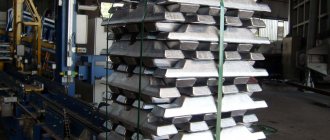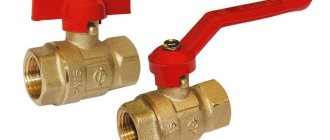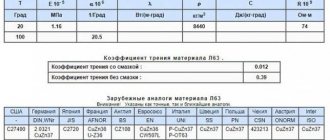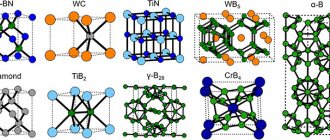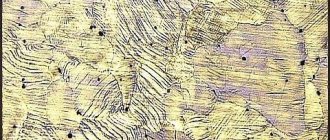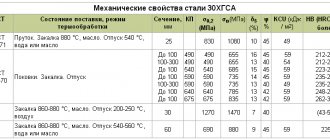What is nickel silver? Judging by its composition and properties, we can say that it is an improved version of an older alloy - cupronickel, invented back in 1819. Unlike cupronickel, which consists only of copper and nickel, nickel silver also necessarily contains zinc, and in addition to it, iron and some other alloying elements.
Nickel silver alloy
Many people may have a question: what is nickel silver?
Nickel silver is an alloy of zinc, copper and nickel. Lead may also be added to it for better mechanical processing.
The presence of zinc makes nickel silver cheaper than cupronickel, which is similar in appearance and has similar mechanical properties. The alloy in question belongs to the group of corrosion-resistant alloys made of copper and nickel. The entire group of alloys from “new silver” has other names: German silver, nickel silver, white metal, argetan, alpaca, cupronickel and others.
Nickel silver has the following markings: abbreviations MNC (copper, nickel, zinc). Next, the percentage of nickel and zinc is prescribed. For example, MNC 25-20 (Ni – 25%, Zn – 20%, the rest Cu). When adding lead, C is added to the name - MNTS. There are approximately 50 types of alloy, but the most common are the grades MNTs 15-20, MNTsS 16-29-1.8.
Each metal in a given alloy has a specific meaning:
- Nickel provides strength and corrosion resistance. When it reacts with copper, it produces a compound that has greater density and hardness. Together they increase the mechanical parameters of copper by approximately 10 times, and its oxidation resistance by 3 times. However, the high nickel content makes the alloy significantly more expensive, and it cannot be processed in red-hot heat;
- zinc replaces nickel. In terms of corrosion resistance, it is inferior to nickel, but is a cheaper metal. The alloy becomes the hardest due to zinc. Due to the annealing procedure, hardness values can be up to 30 HRC. In terms of this value, “new silver” is superior to cupronickel. It also increases electrical resistance and machinability. However, zinc reduces the ability to withstand heat;
- Lead is needed to impart ductility. It makes him pliable. Nickel silvers, which contain lead, are distinguished by the fact that it is not possible to carry out hot pressure treatment with them. The reason for this is that the melting point of lead is at a low level, so hot brittleness defect may be formed.
Properties of cupronickel cutlery
Utensils made of “white copper” were known back in the 3rd century BC. – they tried to melt copper with the addition of nickel. Over time, this technology was lost. Bowls and forks turned black in a humid environment, losing their aesthetic and practical value as table decorations at royal feasts. Imitation of silver and gold was once punishable by execution.
Nowadays, devices made from this material are very popular.
Modern cutlery looks much better than antique ones and can be polished well. Their aesthetic value is determined by the oxidation-resistant metal. Gift sets feature classic and modern designs. Cupronickel melts, cuts, and mints excellently. You can solder, straighten bent teeth of forks, sharpen knives, restore any other device, unlike silver, which is more difficult to process.
Compared to silver, cupronickel is softer, which means it is easy to create openwork products from it.
Cupronickel spoons
The copper-nickel alloy from which cupronickel spoons are stamped looks quite decent and has a characteristic shine when properly polished. The hue of different gift sets can vary - from almost white to yellowish-copper, reminiscent of gilded brass.
For modern tableware, a changed composition of the metal is used: zinc is removed from it, and instead of it, iron acts as a complement to copper and nickel.
Note! Zinc, iron and manganese, which are part of the alloys, were once declared harmful to health due to the possibility of their oxides entering the body. Their percentage is negligible; zinc is not used today
Cupronickel silverware is usually served not only for a festive feast.
It is difficult to answer unequivocally whether such alloys have at least some negative effect on the body. Most likely, devices cleaned of dark deposits do not cause any noticeable harm, but they also do not have the property of disinfecting soda, which is typical for silver ions.
Cupronickel forks
Sets of silverware at an affordable price are, of course, quite affordable cupronickel. Forks with rhodium plated coating, which is resistant to oxidation processes, are most valued. Such items are absolutely harmless, therefore they are widely used in everyday practice.
Important! Forks coated with a layer of silver or gold of several microns cannot be treated with acids and cleaning agents that contain abrasive particles. An alloy that has lost its protective treatment will darken during use.
Cupronickel teaspoons
It’s nice to stir sugar in a cup of coffee or tea with a beautiful cupronickel or silver spoon. This is an excellent gift, even in a single copy, if you engrave it with monograms, in imitation of pre-revolutionary traditions. Today you can find sets of English spoons with dessert tongs.
Even 2-3 centuries ago, people were aware of the intricacies of personal hygiene. Merchants and landowners had their own utensils, including tea and coffee spoons. It was customary to place small cupronickel spoons in rosettes for honey and jam for tea with pancakes, which is still relevant today.
According to research by psychologists, regular use of cupronickel knives, forks, and spoons significantly reduces nervousness.
Historical excursion
The emergence of nickel silver is associated with cupronickel, invented in China. In the 8th century BC e. In China, there was an acute shortage of gold and silver to mint coins from. Then the Chinese ruler ordered alchemists to invent a material that would be less expensive. This is how inexpensive cupronickel appeared. It was durable and could replace coins and jewelry. Chinese scientists kept the composition and formula of cupronickel a secret for a long time, because it was very similar to the precious metal and was much cheaper.
Over time, cupronickel became famous in Europe. The society was interested in the composition of the alloy. European scientists have been trying to solve this mystery for a long time. They discovered the composition of cupronickel (copper, nickel and zinc), but they could not reveal the amount of each metal. Then all experiments were stopped for 300 years. Only in the 19th century in Germany were they able to obtain an analogue of cupronickel. However, in reality the resulting metal was different. It turned out to be the most durable and stable, and the destruction of its composition occurred only in boiling sulfuric and hydrochloric acids. Thus, German chemists invented a new alloy - nickel silver. Its cost is much lower than that of cupronickel and silver.
Then, during the Napoleonic Wars, documentation regarding the "new silver" was obtained by the French. French scientists Maillot and Chaurier discover an alloy of nickel and copper without adding other elements. The resulting alloy is called Myshore. German scientists, as a sign of protest, gave it another name - cupronickel. The Germans were the main ones in metallurgical production, so the name “cupronickel” replaced “mayshore”.
In Germany in 1825, a factory was created that produced cupronickel spoons, forks, and plates on a large scale. Watches, jewelry, etc. were also made from it.
In the 19th century in Europe, cupronickel was widely used. In Russia, it was used only by the poor population, and it was called as Polish silver, German composition, silveroid. However, by the end of the 20th century, the name cupronickel replaced all other names. The word "nickel silver" is a technical term used in metallurgy.
Advantages and disadvantages
Cupronickel tableware has many advantages over products made from other materials. The main ones:
slow heating, which is extremely important for appliances used in the kitchen; cupronickel products have a beautiful appearance; the material does not suffer from corrosion; metal does not bend, because has high strength; Cupronickel has a positive effect on the human body, because
contains nickel and copper ions; the metal has a more affordable price than silver.
In addition, this material has a significant service life and has a positive effect on the human body. It is as follows:
Nickel ions, concentrating in the human body, stabilize the glucose balance, which is extremely important for patients with diabetes; these compounds stabilize blood pressure in hypertension; copper is required by the body for the stable course of protein metabolism processes and maintaining the functioning of the musculoskeletal system; this microelement has a slight antibacterial effect.
Medical experts note that regular use of spoons, forks and knives made of nickel and copper alloy can improve overall well-being, eliminate increased nervousness and aggression, and also minimize the manifestation of seasonal vitamin deficiencies.
Disadvantages of the material:
- Cutlery, dishes and jewelry made of copper-nickel alloy quickly lose their original attractiveness. Dark marks and deposits on the surface are a natural process that is activated due to the oxidation of the material. This metal deficiency is considered the main one.
- Things made from this alloy require regular and proper care. Due to the fact that devices made from this material darken, they must be cleaned regularly to restore their beauty.
- Nowadays it is difficult to find things made from high-quality cupronickel, because... they are produced in small batches.
- Some believe that devices made from this metal have already gone out of fashion. However, this “minus” can at the same time be considered an advantage if we consider a spoon or fork from the times of the USSR as an antique.
How to clean nickel silver
In order for products made from nickel silver alloy to last longer and retain their original appearance, it is necessary to follow some rules. Caring for nickel silver products is as follows:
- Items made of nickel silver must be handled with care and precision: drop them as little as possible, do not scratch, bend, or give them to children.
- Over time, nickel silver may undergo an oxidation reaction in air, meaning it will darken. In order for nickel silver to acquire its original appearance, it is wiped with a cloth that has a coarse composition (wool, flannel, suede). They also use special napkins for silver items. They can be purchased at a jewelry store. Cleaning is carried out approximately once a month.
- To protect the product from environmental influences, it can be varnished. If a varnish is applied to this alloy, there is no need to polish it. However, over time the coating wears off.
- When carrying out household chores or taking a shower, nickel silver jewelry is removed.
- All items made of nickel silver should be stored in closed boxes.
Cleaning small products made from the material in question is carried out by dipping them in a solution of soda, gasoline or potash. They are then rinsed with water and dried using maple wood sawdust. Silver chloride powder can also be used for cleaning.
If all recommendations are followed, nickel silver products will bring joy for a long time.
Storage and care
Caring for cupronickel spoons is quite difficult, especially since cupronickel often darkens. To prevent this from happening, you need to properly care for your cutlery. If they turn black, you should not despair; you can restore them to their original state yourself.
There are many reasons for darkening; the type of product and how it is stored are important. Main reasons:
- high humidity is a real problem for cupronickel spoons, so they are stored in dry places and wiped thoroughly after washing;
- improper care, as food and substances can get into tiny cracks that change the appearance of the device over time.
Various means and methods are used to clean darkened cupronickel spoons. They are perfect for both regular cleansing and old stains.
- Foil. Most often used together with salt and soda. Foil is placed at the bottom of the container, on which the products that need cleaning are placed. They are poured with soda-salt solution and put on fire for about 15-20 minutes. Then turn off the fire and leave the products in water until they cool completely, then rinse thoroughly and wipe dry with a soft cloth.
- Special means. They can be purchased in the hardware departments of supermarkets, they are easy to use, and come in different forms: gel, powder, solution. It is most convenient to use liquid-type products and special wipes. Abrasive substances are excellent for cleaning, but they can damage a set of tablespoons. It is recommended to purchase products that envelop the device after use, protecting it from moisture.
- Soda and vinegar. This is one of the most budget-friendly methods, especially since both products are available in almost every kitchen. About 50 g of soda dissolves in a liter of water, if you use vinegar - 1 teaspoon per 200 ml. Then the products are rubbed with this mixture with a napkin, rinsed, and wiped dry.
- Decoctions. The most popular decoctions for cleaning cupronickel are potato, garlic, and shell decoctions. The shells of two eggs are placed in water (1 liter) and brought to a boil, the darkened product is lowered into it. After a few minutes, take it out and wash it, wipe it. Potato broth is considered a little less aggressive; it is better suited for periodic cleaning.
- Ammonia. 4 tablespoons of alcohol are added per liter of water, and this composition can be used to wash products even with very serious stains.
Often after procedures, cupronickel spoons become dull; to restore the lost shine, various methods are used:
- toothpaste or powder - products are simply rubbed with a product applied to a cotton pad;
- potatoes - you will need half a raw root vegetable, which is used to wipe cutlery;
- pasta - place the utensils into a pan with boiled pasta for 20 minutes, leave the water in the pan, then wash and dry it, and throw away the pasta.
To ensure that cupronickel spoons retain their original appearance for a long time and do not require frequent cleaning, the following rules must be observed:
- do not store devices in places with high humidity in a closed box; it is better to wrap each of them with food-grade film;
- do not use aggressive care products with chlorine, for example, “Belizna”;
- Wash nickel silver utensils only by hand; they cannot be washed in the dishwasher.
To see how easy it is to clean cupronickel in two minutes, watch the following video.
Nickel silver casting
Casting nickel silver is a complex business. The casting temperature for nickel silver is 1120 °C. According to statistics, when you independently form nickel silver using information from the Internet, 90% of defects are obtained. The efficiency of casting in open systems under pressure is within normal limits if the defect rate is not more than 50%. To get a 100% result, you need to use a specific alloy and a certain type of injection molding machine.
At the moment, the alloy in question is mass produced. When casting nickel silver, the greatest attention is paid to the casting machine and production technology.
Physical properties of nickel silver
The GOST 5187-2003 standard regulates the incoming elements of nickel silver. According to this document, the alloy in question must contain:
- nickel: from 5 to 35%. The alloy has a yellowish-white tint with a nickel content of 5-10%, and with a nickel content of 20-30% it is silvery-white;
- zinc: 13-45%;
- copper: remainder;
- Lead may be added up to 5%.
Download GOST 5187-2003
The most common percentage of metals included in this alloy:
- copper – 65%;
- zinc – 20% (main component);
- nickel – 15%.
The main physical properties of this alloy include:
- density 8700 kg/cub.m.;
- zinc and nickel reduce electrical conductivity. The electrical resistivity is 0.26 ohm×mm2/m. This is 30 times more when compared with the same indicator for copper;
- the average thermal conductivity is 0.06-0.085 cal/cm×C. That is, the alloy in question conducts heat poorly;
- Nickel silver does not have a high rate of expansion with increasing temperature. When the temperature rises to 100˚C the alloy expands only 16.6 microns.
Cupronickel – Silver
Today, as we mentioned above, cupronickel in its pure form is almost never used. Just like nickel silver. Well, not counting technical products, complex spare parts and electrical circuits. Almost all products that make sense to compare in the format “differences between cupronickel and silver” are made from cupronickel or nickel silver coated with silver. Let's try to consider the main points in the differences between cupronickel and silver.
Useful properties of silver. Everyone has probably heard about antibacterial, disinfectant, cleansing, etc. properties of silver. And here, I think, you still need to pay extra and buy silver cutlery or dishes. But be that as it may. Oddly enough, cupronickel is better than silver in this regard. The reason is banal. Silver products are made from 925 silver (called “sterling”) or lower, which is 92.5% silver and 7.5% copper. In contrast, cupronickel silver cutlery and dishes are coated with a layer of 999.9 pure silver (99.99% silver, 0.01% impurities). As a result, in terms of the beneficial properties of silver, cupronickel is more useful than silver.
Strength. We already wrote above that cupronickel is superior to silver in strength, nickel silver and brass have similar properties. This means that, for example, cupronickel cutlery will be more resistant to bending and breaking, which means they will be more durable and will most likely retain their original shape longer. Here again, cupronickel is ahead.
Thermal conductivity. Silver is one of the metals with the highest electrical and thermal conductivity. Cupronickel and similar alloys have lower values. It would seem that cupronickel has been caught, but no. Lower thermal conductivity is just better for dishes and cutlery. The walls of dishes and cutlery will heat up more slowly and to a lesser extent when in contact with hot food products, which means using cupronickel in this case will again be more comfortable than silver.
Price. Here it is clear - cupronickel is much more affordable than silver.
Product thickness. The lower price of cupronickel reveals the fact that cupronickel products, as a rule, are made more massive due to the greater availability of the material. This usually means that such products will be more comfortable to use.
For example, the thickness of cutlery is one of the main indicators of their quality.
Premium. The only thing that silver has left after the widespread introduction of cupronickel is its high price, which means silver dishes and cutlery remain premium-segment goods and goods of symbolic significance and are used by those for whom it is important to emphasize their status, or the status of a certain event. Silverware was, is and will be
Melchior will never keep up with silver in this regard.
Mechanical properties
The main mechanical properties include:
- melting point: 1080 ˚С. Complete melting occurs at 1200 ˚C;
- increased strength when compared with other alloys of copper and nickel. A high rate provides additional alloying of zinc. Strength is 38-45 kg/mm2;
- deformation begins at 10 kg/mm2;
- slight elasticity. The Young's modulus of the alloy is not more than 14,000 kg/mm2. This indicator for structural steel is 20,000 kg/mm2;
- retains its metallic appearance when immersed in water;
- does not dissolve in organic acids diluted with water, acetic and lactic acid;
- has good ductility in hot and cold. The relative tensile elongation is 25-45%, and the contraction elongation is 32%.
Thanks to these indicators, this alloy is widely used in the production of various types of products. Alloys easily lend themselves to pressure processing options such as embossing, broaching, and stamping.
What is cupronickel
If we say in clear language and unambiguously what cupronickel is, then it is an alloy of copper and white nickel. It is very similar in color to silver, therefore it has been successfully “adopted” in the jewelry industry, the production of coins, dishes and other products with the initial goal of replacing silver with a cheaper analogue. The introduction of cupronickel was very successful, since with proper processing, cupronickel products are very difficult to distinguish from silver, at least in color and basic properties. The most noticeable difference from silver is that cupronickel is noticeably superior to silver in mechanical strength. In addition, various parts, electrical appliances, etc. are made from cupronickel.
It is generally accepted that cupronickel alloy was created by the French inventors Maillot (Mayo) and Chorier (Chorier) in the 19th century and it received its name precisely from the combination of their names, distorted in the German language. Maillot-Chorier eventually became Melchior. The French initially called their alloy nothing more than “maishor”, but this name did not stick. However, according to other sources, cupronickel was known back in the third century BC under the name “white copper”, but for unknown reasons was forgotten for two millennia, only to be rediscovered under a different name, which turned out to be very pleasant to the ear and became very popular. Also, a similar alloy was known in medieval China as "pakfong" or "Chinese silver" - presumably an alloy based on bronze, nickel and zinc. Pakfong is considered the progenitor of the nickel silver alloy, which is also very similar to cupronickel. Despite the fact that the creation of the alloy is attributed to French scientists, cupronickel is often referred to as “German silver”.
The word "cupronickel" itself was not invented in the 19th century. According to Western European church traditions, Melchior is the name of one of the three wise men who came to the newborn Jesus with gifts for Christmas. The names of the Magi are not mentioned in the Gospel; it is believed that their names “appeared” in the Middle Ages. By coincidence, the name Melchior seemed to someone to be consonant with two names, or rather the names of the inventors who discovered this alloy. The resulting name for the alloy has become so ingrained that, out of habit, even some similar alloys are now called cupronickel.
Chemical properties
The alloy composition has the following chemical properties:
- good resistance to destructive environmental factors;
- it does not oxidize in air. At temperatures up to 250 ˚С there is no chemical reaction between nickel silver and atmospheric gases;
- increased resistance to corrosion, to a large number of acids, especially organic acids. To increase the corrosion resistance of nickel silver products, immerse them in an aqueous solution of sulfuric acid after cleaning, then rinse them with water and dry them;
- inert to salts.
Resistance to external environmental factors and other characteristics of nickel silver determine its widespread use.
Applications of nickel silver
Nickel silver is mostly used in the jewelry industry. The reason for this is that it looks like silver. Various costume jewelry and award badges are produced from this alloy. It is also used as a base for gilding jewelry. The MNTs 15 brand is used for the production of jewelry. This type is the most durable and is characterized by a high wear resistance.
The alloy in question is used in the production of essential goods.
Nickel silver has also been used in the technical field. Various parts for electrical appliances are produced from it. For example, a spring relay for a clock mechanism. They have a flat shape and elasticity, which is necessary for use in electrical appliances. Frets for acoustic and electric guitars are also made from this alloy.
The alloy is used for the manufacture of certain types of medical equipment and for the production of measuring instruments. It received this use due to the fact that it is easy to disinfect and does not react when used.
The alloy in question is used to produce dishes and cutlery. However, the nickel contained in it is a strong allergen for the human body. Approximately 20% of the population suffers from an allergic reaction to nickel. Therefore, nickel silver dishes are coated with gold or silver. This protects the body from direct contact with the alloy. Also, cutlery that is not coated with this coating will give the food a metallic taste. With the presence of precious metal, such a taste does not appear. Some countries have imposed restrictions on the production of nickel silver products. In addition, nickel silver tends to lose its shine with prolonged use.
Additionally, nickel silver is used in the production of equipment that operates through a water and steam system.
Many countries around the world have replaced the production of coins from silver with the production of coins from nickel silver.
At the beginning of the 20th century, nickel silver began to be used in architecture. It gained particular popularity after the exhibition in Paris in 1925. Ornaments coated with this alloy are widely used in the interior and exterior decoration of buildings.
The Russian Ministry of Health has approved the use of nickel silver for use in the food industry.
Nickel silver as a coin metal
Although nickel silver has never been a popular alloy for coinage, it has sometimes been used for commemorative, limited or collector's editions, as well as specific single editions.
An example is the 20 kopeck coins minted in 1961. The design of the coin was not complex - it was an ordinary batch. And now among numismatists, samples of twenty-kopeck coins from 1961 are not valued very highly, despite the uncharacteristic metal.
In recent years, commemorative coins made of nickel silver have been minted in Ukraine and Kazakhstan. In Kazakhstan, these are a series of coins with a face value of 50 tenge, dedicated to one of the themes: “Fairy Tales”, “Space”, “Cities”, “Red Book”. In Ukraine, coins of different circulations and denominations were minted: in honor of famous people, memorable dates (many relate to the Great Patriotic War), cities.
Source
Technological characteristics
The red tint of copper is quenched by the high nickel content. As a result, the alloy becomes white and has a blue or green tint. The specific gravity is 7.5 g/cubic meter. cm. Brinell hardness is 80 kg/mm.
To obtain a high quality alloy, various standards are followed. The rules of GOST 492-2006 regulate the production of alloys MNTs 15-20, MNTs 12-24, MNTs 18-27, MNTs 18-20. All alloy options are a variety of rods, sheets, tubes, strips and strips. The difference between them lies in the different amounts of nickel and zinc. Composition of MNC 15: 13.5%-16.5% nickel, 18%-22% zinc. This version of the alloy is called a single-phase alloy. It is a solution in a solid state. Its special feature is that it can be processed hot or cold using the pressure method.
When cutlery is produced from the alloy in question, it is plated with gold or silver. This procedure is necessary to prevent metallic taste during application. Coating standards are regulated by GOST 24320-80. They prescribe the following standards:
- for cutlery 24.00 µm (deviation ±3.60 µm possible);
- for knife handles 18.00 µm (deviation ±2.70 µm possible).
Download GOST 492-2006
Download GOST 24320-80
When applying gold to silver, the thickness is 0.5 microns.
Marking of silver and silver-plated products
Some time ago I was faced with the need to understand the markings of Italian silver. And when I shared this information with my friend, who has long had a vintage store here at the Crafts Fair, she was surprised to learn that she also did not know all the intricacies of marking silver items. That’s why I decided – I need to write about it!
So, I am sharing useful information about marking silver products. Silver items in Italy are marked with the numbers 800, less often 925 (as a rule, 925 silver is used in jewelry). These numbers mean that every 1000 units of material consist of 800 (or 925) parts of silver and 200 (or 75) parts of copper. Pure silver is not used in the production of interior items, tableware and jewelry, as it is too soft. I will write about the evolution of the hallmark of Italian silver products a little lower.
Foreign, non-Italian silver items may have different markings. Thus, American silver is often marked Sterling, which is analogous to the 925 marking. English craftsmen use the “walking lion” symbol, which guarantees the 925 marking, and, in addition to this symbol, they put a mark with the date and city of manufacture, and older products have information about head of state. The rest of the European countries, except England, use the same labeling as Italy.
Not only silver items are marked. So, for example, I came across the mark of Alpacca, an alloy in composition very similar to cupronickel and nickel silver. None of these alloys, cupronickel, nickel silver and alpaca, contain silver, but alpaca makes a very good base for silver plating, and nickel silver cutlery is almost always plated with a thin layer of silver to remove the metallic taste. Some English and American items are marked German Silver, which means nickel silver. The Sheffield mark is also not silver, but old Sheffield pieces are always very high quality and therefore have a high value.
I would like to draw your attention to the Arg.800 and Arg.1000 markings used by Italian craftsmen. This marking means that the product is not silver, but silver-plated, that is, a thin silver layer is applied to the surface of the alloy, most often by galvanic method
Well, a little more about the evolution of the silver hallmark in Italy. Italian craftsmen were required to use a single mark by law of May 2, 1872. A woman's head was used as a brand. The head with the number 1 was an analogue of 950, with the number 2 - 900, and without the number - 800.
From 1890 to 1934, markings were only numbers, without an oval, often in parallel with the symbols previously used by the jeweler, such as a flower.
With the advent of fascism in 1934, another mark was added to identify jewelers. The 800 marking was now located inside an oval, and they also began to use a hexagon containing the manufacturer's identification number, the littorio (symbol of fascism) and the initials - the abbreviation of the province in which the object was made.
With the end of the Fascist period in 1944 and until 1968, the same marking 800 inside the oval and the hexagon containing the manufacturer's identification code with the initials of the province in which the object was made continued to be used, but the littorio ray disappeared in the hexagon.
Since 1968, the 800 or 925 marking has always been enclosed in an oval, but the shape of the hexagon has changed - a star appeared inside, then the manufacturer's number and, finally, an abbreviation of the initial letters of the province where the product was made. This marking is still in use today.
PS All labeling data was taken from Italian websites, as well as after consultation with specialists in vintage products and antiques. Unfortunately, I couldn’t attach photos: those available on the Internet are too small in size.
What is the difference between cupronickel and nickel silver?
The main difference between cupronickel and nickel silver is the presence of zinc in the composition of the latter. Cupronickel is an alloy of copper (80%) and nickel (18%) with a silvery color. Nickel silver is an alloy of zinc, copper and nickel.
The most significant property of cupronickel is its increased resistance to corrosion. It is highly durable and looks similar to silver. Due to these qualities, it is often used in the production of tableware.
Externally, cupronickel and nickel silver are very similar. Therefore, the question arises of how to distinguish nickel silver from cupronickel. At first glance, it is almost impossible to distinguish them. The distinction can only be made by knowing the composition of the alloys.
Markings used
For all products made from cupronickel, the sample is designated by two capital letters: M and N. They mean that the alloy contains copper and zinc. If next to the letters MN are also indicated Zh, as well as MC, then manganese and iron were used in the form of a ligature. In addition to the standard letter designation, numbers are also used in production. For example, if the product is marked MNZHMts 30−1−1, then the alloy, in addition to the standard copper base, contains 30% nickel, 1% iron and 1% manganese.
On the territory of Russia, cupronickel devices and jewelry were especially actively produced before the collapse of the USSR. After this, the alloy began to be produced at a serial level with the addition of zinc. Thanks to this, nickel silver (one of the varieties of cupronickel) was obtained. Today, products made from a copper-nickel alloy without the addition of zinc can only be bought in an antique shop. In appearance and strength, nickel silver devices cannot be distinguished from real silver, but only expensive metal can darken as a result of contact with a damp surface.
A distinctive feature of the copper-nickel alloy is its mark - MNC. But in some cases there may be no sample on the product. To correctly determine the marking, you need to find out the date of manufacture or evaluate the color of the device or decoration. If there is a yellow tint in the alloy, then we are talking about nickel silver.
